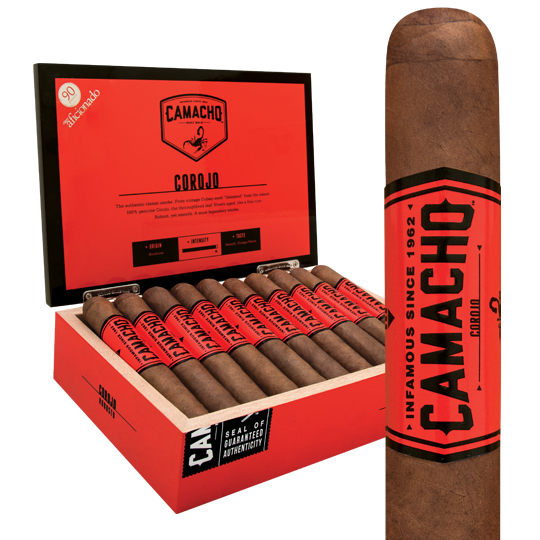Camacho Corojo Toro Staff Review
My earliest cigar smoking memories and purchasing decisions were shaped by the Cigar Boom of the 1990s. To help sum it up, I’d like to borrow a line from famed literary novelist Charles Dickens in A Tale of Two Cities, “It was the best of times, it was the worst of times, it was the age of wisdom, it was the age of foolishness…” Let that marinate in your brain for a fleeting moment as we proceed down memory lane with the wit and wisdom of yours truly.
It’s been 20+ plus years since Camacho appeared in my regular smoking rotation. Way back then, it resided in the top-shelf of my self-converted, cedar-lined coolerdor. To put that in perspective friends, lesser feats have been awarded parade permits, Academy Awards, and Nobel Peace Prizes! I fondly recall the basic but stately, vintage-looking Camacho Corojo brand. It was no-frills at its finest. The blend was full-bodied and the pre-light aroma emanated a familiar barnyard smell of spicy earth blessed by the fertile Honduran soil it was cultivated in.That was the best of the times – the pinnacle of Camacho, in my humble opinion.
The opposite came in 2008 when the Eiroa family sold the Camacho brand to Davidoff of Geneva. I remember attending the first IPCPR tradeshow after the Davidoff acquisition. The new-look Camacho was unveiled with packaging that reminded me more of Everlast boxing gloves than cigars. To make things weirder, the folks at Davidoff also derived a ‘bold, scorpion-themed’ marketing campaign, which resulted in a random display of live scorpions roaming around a fish tank in their trade show booth. Over the last 10 years, Davidoff’s continued rebranding efforts for Camacho have included scorpions, oversized cigar bands, rainbow-colored boxes, 18-wheel trucks, and Mike Ditka. I couldn’t make this stuff up if I tried.
For this review I procured a box of Camacho Corojo Toro. The fire-engine-red box immediately caught my attention. It contains 20 traditional 6 x 50 Toro-sized cigars emblazoned with the stinging scorpion logo with pinchers spread and tail tightly coiled ready to strike. As I remove the cigars from the box, I immediately notice the band obscures nearly a third of the cigar. The cap was neatly applied, so I elected to use a bullet cutter before commencing with a cold draw. An acidic, tart note dominates the palate with underpinnings of damp cedar.
As flame touches foot, a black soot encapsulates the wrapper and binder and inhibits complete combustion. A few puffs later the all-Honduran filler tobaccos catch ablaze and offer pucker-inducing, eye-twitching notes of tart black cherries and leather that sting the nostrils like an angry bumblebee on the retrohale.
After the first inch of the cigar is smoked, roughly 15 minutes have elapsed. The draw eases up a bit and offers a sweet and spicy amalgam that’s both unique and short-lived. The cigar begins to burn uneven so I’m forced to touch up the wrapper and binder with pinpoint precision, courtesy of my trusty triple-flame jet lighter.
I have to remove the cigar band after 25 minutes have passed. It’s something I normally don’t do, especially after the cigar is lit. I have to do it on this cigar because the band is quite large. As a result, I suffer the unpleasant consequences of dropping a flaky gray ash all over – and worse yet, I errantly remove a portion of the delicate wrapper that was affixed to the cigar band. The takeaway here friends is you don’t smoke the packaging – or the cigar band!
I continue with the cigar sans band even though a section of the wrapper is now missing. I’d normally discard the cigar at this point, but I wanted to see if the flavor would continue to develop. It was a good decision, albeit too late, because I was already well past the halfway point of the cigar.
In conclusion, at its peak, I was able to detect a measureable full-bodied strength with notes of cayenne and black licorice complemented by a lingering sweetness. Too little, too late, I guess.
For about $8 a cigar, it’s worth a shot and deserving of my 68-point rating!
Until next time, long ashes to you!






